These highlights chronicle the year 2013. Created
incrementally as new photos were available, the year runs generally
"backwards" on this page. The abbreviation "MTY" means "Monterey County"
in the text below. Text by Don Roberson. Photos on this page
are copyrighted by the photographers to whom they are
attributed, and may not be reproduced in any form (including
other web sites) without the express consent of the photographer.
|
|
| Depicted below in sequence is "The Battle at the Point," witnessed at Pt. Pinos on 8 October — a King of the Hill
game featuring one Blue-footed Booby and a horde of bullying Brandt's
Cormorant. Start the panel below and go clockwise around the perimeter.
You are just a wayward Booby who has discovered a nice high point on
which to rest and, hopefully, get a nice long nap. . . But no, every
few moments you are bombarded by cormorants wanting 'your' spot. Some
even grapple with you beak to beak. You do manage about an hour's nap
(albeit interrupted) when a particularly loathsome beast lands right
atop you and forces you into the air! You circle the Point looking for
a new spot — finally finding another spot on the next rock over — but
then a look behind you reveals a phalanx of cormorants all approaching,
and up into the air you go again . . . this flying off south, looking
for a much quieter rock to enjoy . . . |
|
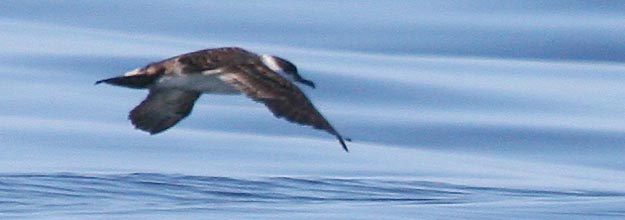
Offshore
— some 6.4 miles west of Hurricane Point on 5 Oct — a boatload of
birders on a Shearwater Journeys trip (Tom Johnson, John Garrett, et
al.) located an obliging Great Shearwater (right
© Scott B. Terrill). This represents just the 5th or 6th record
for MTY, with a couple of others from the SCZ side of Monterey Bay. |
|
A (possibly imm female) Prothonotary Warbler
was beautifully photographed at Laguna Grande Park on 26 Sep (above
left © Beth Hamel). The rich yellow color contrasts nicely with
the deep blues of this male Blue Grosbeak found by
Paul Fenwick at Carmel SB (just below 'Cross Hill') on 29 Sep (photo
above right © D. Roberson). The grosbeak did not stay long, but
fortunately the Prothonotary did linger, especially
around an alder tree at the 'gray bridge' at the east end of the lake,
and it was seen by many well into October. On its final date, Gary
Woods managed this truly stunning shot (below 6 Oct © Gary Woods).
This gorgeous vagrant had remained fully 12 days — much longer than
most fall migrants.
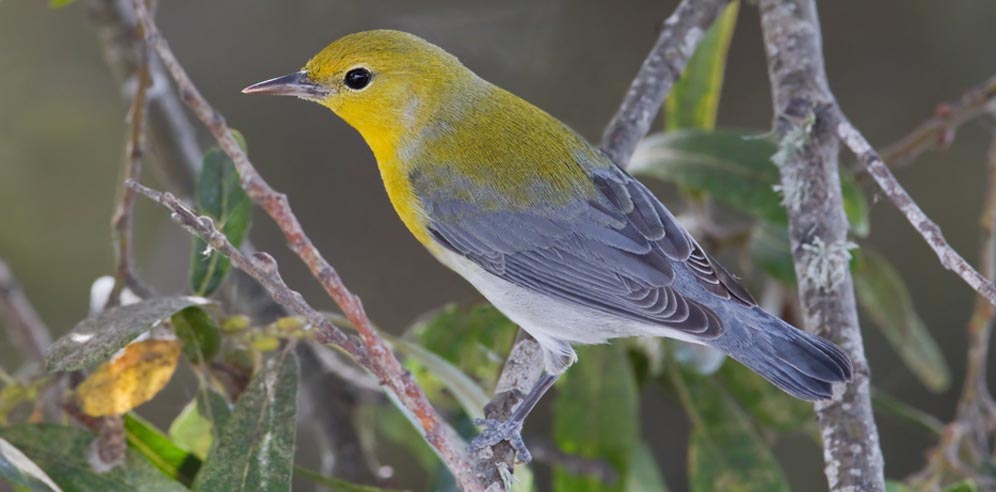
|
| Meanwhile, shorebird activity at a permit-only site near Salinas produced a couple of fine rarities in late September: Buff-breasted Sandpiper (below left) and Sharp-tailed Sandpiper
(below right), both found by Paul Fenwick and Gary Woods on 26 Sep. Up
to 60 Pectoral Sandpipers were also present, with 48 counted in a
single pond. [Both photos below are from 26 Sep; © Gary Woods].
Fortunately, Rick Fournier found another Sharp-tailed Sandpiper at Moonglow Dairy on 5 Oct — a site open to the public — and that bird remained well into October. |
|
| The
ten days between 15-24 Sep were as exciting a period of birding time as
we have seen in decades — and all because of an 'invasion' of Blue-footed Boobies
into coastal northern California. The only prior invasion that brought
this booby to MTY was in October 1971 (4 birds together on 16 Oct, 2
present the next day — both in feeding flocks off Lovers Pt.). Now, 42
years later, an incursion in southern California had begun during the
second week of September. The northward movement of these birds would
bring them to Monterey Bay. |
|
On
15 Sep, Brian Sullivan went sea-watching at Pt. Pinos — looking for
boobies arriving here — and at 5:15 p.m. he scoped one plunge-diving
among a feeding frenzy of pelicans in Monterey Bay. Within 5 minutes it
had drifted out of sight. Santa Cruz Co. had a flurry of observations
that week, but MTY sightings were absent until 18 Sep, when Cooper
Scollan had 3 fly past him in Monterey Harbor and out to sea. At this
point some birders began long "booby watches"at Pt. Pinos; one observer
logged 26 hours over the week. Blake Matheson had a young Blue-foot fly
past him at Pt. Pinos just after 7 p.m. sunset on 18 Sep. Paul Fenwick
had an immature flying north past the Point at 11:23 a.m. on 19 Sep.
Larry Rose spotted one for 4 observers there at 7:11 p.m. on 20 Sep. On
21 Sep a whale-watching trip had one and alerted Richard Ternullo, who
saw it fly past the Point 20 minutes later. It was not until mid-day on
24 Sep when Paul Fenwick spotted one sitting on the north jetty at Moss
Landing (all photos surrounding this text) that a Blue-footed Booby was seen perched in MTY. It was present for about an hour.
[Photo above digiscoped © D. Roberson, right © Paul Fenwick, the two below © Rick Fournier
— the latter shot shows it taking off at 12:24 p.m. after a large wave
crashed into the jetty. The booby shows some post-juvenal wing molt, so
would appear to be about a year old.]
It
is hard to determine how many Blue-foots have been in MTY over these 10
days. Photos of Sullivan's Pt. Pinos bird on eBird show an older booby
than those passing the Point later that week. Three together in
Monterey Harbor could be the same or different birds, as could the Moss
Landing bird. It is a minimum of 3 but could be as many as 6 or more.
|
|
|
|
|
| The final Blue-footed Booby
observation in September was by Paul Fenwick again — one flew south
past Pt. Pinos on 27 Sep with a flight of Brown Pelicans, and Paul got
this photo (right © Paul Fenwick). This was his 3rd observation of
a booby during the span, while many other birders are still hoping for
their first ! |
|
|
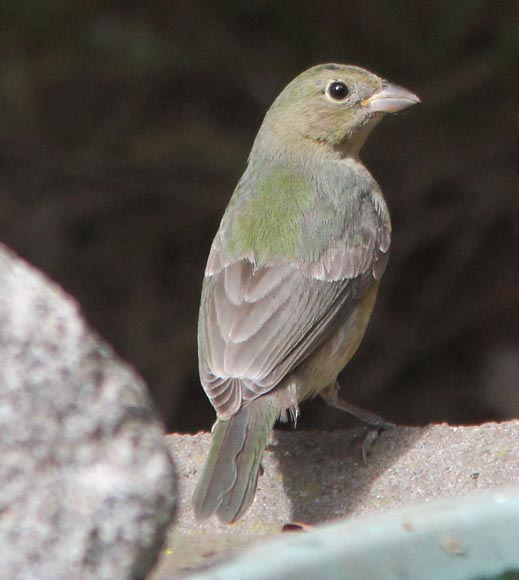
While not as impressive of a booby, an imm female Painted Bunting that frequented a backyard in Pacific Grove 22-23 Sep was an outstanding yard bird (photo left © Don Roberson).
This same yard attracted a young American Redstart to the bird bath on 1 Oct (photo below © D. Roberson).
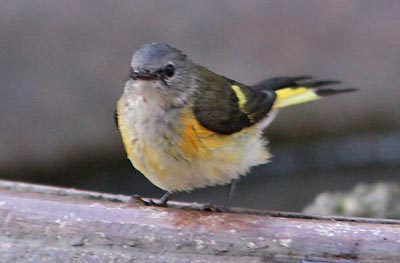
|
|
|
| This young Eastern Kingbird
(above) along South Bank Trail in lower Carmel Valley was a snappy
start to September. Found 9 Sep by Chuck Bancroft, it was still
swallowing flies around the stables on 12 Sep (this photo © D.
Roberson). As is typical, one to three Northern Waterthrush
were along the Carmel River mouth, foraging at the riparian edge of
shaded pools, during the first 3 weeks of September, but rarely is one
so well-photographed as this one that ventured into sunshine on 15 Sep
(below © Catherine Webb). |
|
|
Crespi
Pond, on the Pacific Grove golf course right near Pt. Pinos, has hosted
many rarities over the years. In August-September this fall, water
levels in the pond fell and it attracted some local rarities, including
a young White-faced Ibis from 6 Sep (photo above © D. Roberson), and a juvenal-plumaged Semipalmated Sandpiper
from 21-22 August (Blake Matheson; photos below 22 Aug © Blake
Matheson [left] and © Gary Woods right]— note webbing between toes
on latter shot). While a tiny handful of juv "Semis" appear annually in
the Moss Landing and Salinas vicinities each autumn, this was a first
record for Crespi Pond. |
|
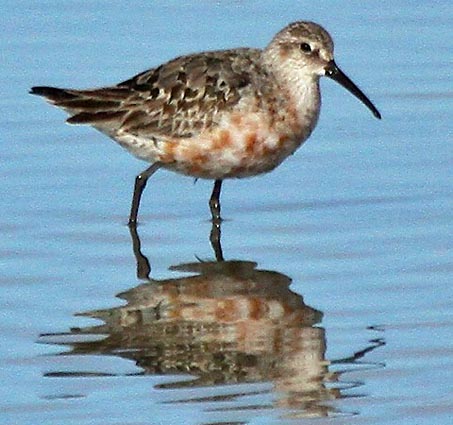
Undoubtedly the highlight of the shorebird season in 2013 was this adult Curlew Sandpiper
(left and below) found by Rick Fournier on 15 August at a wetland near
Salinas that is not open to the public (pre-existing permit holders
only). This was only the second record for MTY and one of very few for
California. It remained to 20 August. The bird was an adult in
pre-basic molt, showing remnants of breeding plumage (reddish patches
below, dark feathers above) as fresh pale-gray basic plumage feathers
were starting to dominate the upper back. Photos here are from 15 Aug
© Rick Fournier (left) & © Bill Hill (below left), and
from 18 Aug © Brian L. Sullivan (below right, showing white rump).
|
|
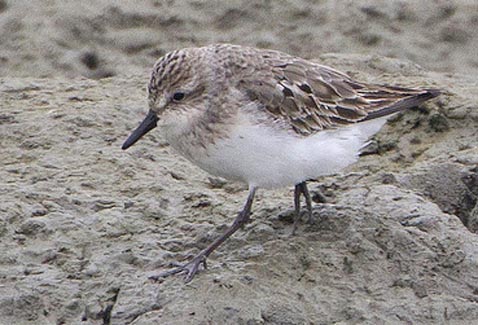
This permit-only wetland near Salinas also hosted other rarities this fall, including a rare adult (or first-summer?) Semipalmated Sandpiper on 19 July that was already well into pre-basic body molt (photo right © Brian L. Sullivan), a young Franklin's Gull
molting from juvenal to first-basic plumage from 13-22 August (found by
Rick Fournier; photo below left 18 Aug © D. Roberson), and a
subadult (second-summer?) Parasitic Jaeger on 18 Aug
(found by Rita Carratello; photo below right © D. Roberson). This
is the 4th time that a jaeger has appeared 7 miles inland at these
ponds. Three have been Parasitic and one was a Long-tailed (back in Sep
1990). |
|
| Another excellent wader in early fall came from just across the MTY/SCZ border at the Pajaro River mouth. An adult Lesser Sand-Plover appeared
each morning on the beach in front of the Pajaro Dunes Colony, Santa
Cruz Co., from 2–4 August. Each morning before 9 a.m. it flew towards
Monterey County but disappeared before it reached the county line, and
could not be relocated the rest of the day. There are three prior
records of this species in MTY (Sep 1980, Aug 1989, Sep 1992) but this
was a first for SCZ; photo (below) 4 Aug © D. Roberson. |
|
|
TOP
GO TO
HOME PAGE
TO MONTEREY
COUNTY
PAGE
TO BIRD
FAMILIES
OF THE WORLD
|